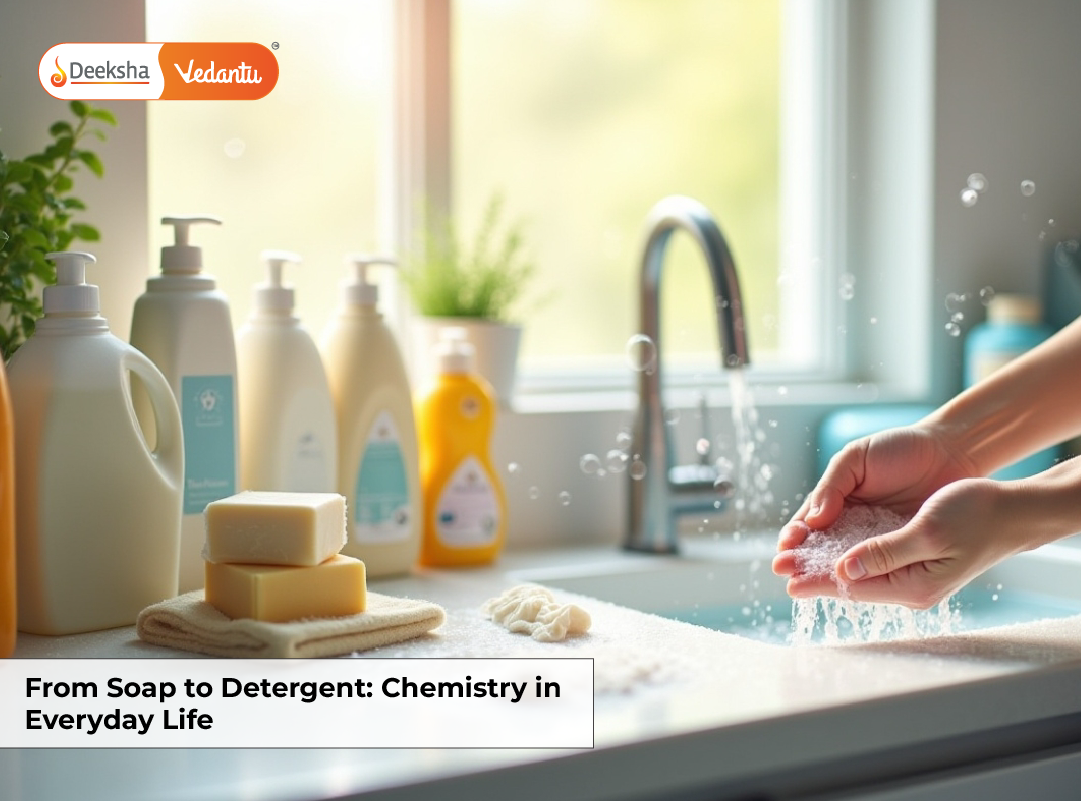Introduction
Soap and detergent are not just household items—they’re marvels of applied chemistry known as surfactants. Whether you’re washing your hands, doing laundry, or cleaning your dishes, you rely on the cleaning power of these substances every day. But have you ever wondered how these substances work? What sets them apart chemically? And why do some work better than others in hard water?
This blog breaks down the basics of soaps and detergents, exploring their chemistry, applications, and significance in daily life. We’ll also explore how innovations in chemistry continue to improve cleaning technologies while addressing environmental concerns.
Explore the full chapter: Soaps and Detergents
The Chemistry of Cleaning: What Are Soaps and Detergents?
Soap
Soaps are sodium or potassium salts of long-chain fatty acids. They are made by the chemical reaction known as saponification, where fats or oils react with a base like sodium hydroxide () to produce glycerol and soap.
Saponification Reaction:
This process has been used for centuries and is considered one of the oldest chemical manufacturing processes. Soaps are typically solid when made with sodium salts and liquid when made with potassium salts. They work effectively in soft water but may lose their cleansing ability in hard water.
Detergent
Detergents, on the other hand, are synthetic compounds made from petrochemicals. Like soaps, they act as surfactants, but they are more versatile and stable. Their chemical structure allows them to work effectively in both soft and hard water without forming scum.
Detergents are formulated with additional components like enzymes, optical brighteners, and fragrances that enhance their effectiveness. These additives make them ideal for a wide range of applications, from home use to industrial cleaning processes.
Difference Between Soap and Detergent
| Feature | Soap | Detergent |
| Source | Natural fats and oils | Petrochemicals |
| Reaction with hard water | Forms scum | Works effectively |
| pH Sensitivity | Less effective in acidic water | More stable in various pH ranges |
| Biodegradability | Generally biodegradable | Some may be non-biodegradable |
| Cost | Usually cheaper | Often more expensive |
| Additives | Fewer additives | Includes enzymes, whiteners, etc. |
| Environmental impact | Lower with natural sources | Varies based on formulation |
Learn more: Acids, Bases and Salts
How Do They Work?
Both soaps and detergents reduce the surface tension of water, allowing it to spread and wet surfaces more easily. They contain molecules with two distinct parts:
- Hydrophilic (water-attracting) end
- Hydrophobic (water-repelling, dirt-attracting) end
When used with water, these molecules arrange themselves to trap dirt and grease, which are then lifted off surfaces. The cleaning action is the result of these molecules surrounding non-polar particles like oil and forming micelles.
Micelle Formation
In water, the hydrophobic tails trap oil and grease, while the hydrophilic heads remain on the outside. This forms a spherical structure that can be rinsed away with water. Think of a micelle like a tiny grease-trapping bubble—similar to how a sandwich holds fillings together, these molecules surround dirt and lift it away.
Micelle formation is crucial to the cleaning action of both soaps and detergents. These micelles remain suspended in water, keeping the trapped dirt from re-depositing on clothes or surfaces.
Real-Life Uses of Soaps and Detergents
Soaps and detergents have become essential in modern life, each with their own specific roles:
Soaps:
- Personal hygiene (bathing, handwashing)
- Shaving creams and facial cleansers
- Surface cleaning in soft-water regions
- Ingredient in cosmetics and medicated skin products
Detergents:
- Laundry detergents for clothes
- Dishwashing liquids and powders
- Floor, window, and appliance cleaners
- Heavy-duty industrial cleaning agents
- Engine degreasers and stain removers
Explore further: More About Salts
Chemistry in Daily Life
The chemistry behind cleaning products is a great example of how science shapes our daily routines. Whether you’re choosing a mild cleanser for your skin or a heavy-duty detergent for stains, understanding the chemistry involved helps you make informed decisions.
Products are tailored with features like:
- pH balance for sensitive skin
- Antibacterial agents for hygiene
- Fragrances for pleasant aroma
- Enzymes to break down proteins or fats in stains
Chemistry not only improves product performance but also guides efforts to reduce environmental impact through biodegradable ingredients and minimal residue.
Explore the basics: What Do All Acids and All Bases Have in Common?
Types of Detergents
There are different categories of detergents, each serving unique purposes based on their chemical properties.
1. Anionic Detergents
These are the most commonly used. They have excellent cleansing properties and are used in laundry powders, hand soaps, and toothpaste.
2. Cationic Detergents
These carry a positive charge and are used in conditioners and fabric softeners. They are often added for their ability to soften fabrics and kill bacteria.
3. Non-ionic Detergents
These do not carry any charge and are gentle on the skin. Used in dishwashing liquids, baby products, and eco-friendly formulations.
4. Zwitterionic Detergents
These contain both positive and negative charges. They’re used in specialized products such as laboratory and biomedical cleansers.
Environmental Impact
While soaps are typically biodegradable due to their natural origin, synthetic detergents may include components that do not break down easily. This poses risks to aquatic ecosystems, as residues can accumulate and affect aquatic life.
New formulations focus on:
- Biodegradable surfactants
- Plant-based ingredients
- Phosphate-free detergents
- Minimal packaging waste
It is increasingly important to choose products with certifications such as “EcoLabel,” “USDA Certified Biobased,” or “Green Seal” to support sustainable consumer habits.
Governments, manufacturers, and researchers are collaborating to develop green alternatives using renewable resources and non-toxic chemicals.
FAQs
1. What is the difference between soap and detergent?
Soap is made from natural fats and oils through saponification, while detergent is synthetically made from petrochemicals. Detergents are more effective in hard water conditions.
2. How do soaps and detergents work?
They have a hydrophilic head and hydrophobic tail, allowing them to trap grease and wash it away in water through micelle formation.
3. Why do detergents work better in hard water?
Soaps form insoluble salts (scum) with calcium and magnesium ions, while detergents do not, making them ideal for hard water.
4. Are detergents biodegradable?
Not all. Some modern detergents are designed to be eco-friendly. Always check the label for information about environmental safety.
5. What are micelles?
Micelles are spherical structures formed by soap or detergent molecules that trap grease and dirt at their center, enabling easy removal with water.
Explore more: Understanding the Chemical Properties of Acids and Bases
Conclusion
From the simple act of washing your hands to cleaning industrial surfaces, the role of soaps and detergents is undeniable. Chemistry provides us with the tools to create effective cleaning agents, understand their behavior in different environments, and innovate for a cleaner, greener world.
As awareness of environmental sustainability grows, the focus is shifting to more biodegradable and plant-based solutions. Education about these topics helps students understand the profound impact chemistry has on hygiene, health, and the environment.
Quick Recap:
- Soaps are natural and best for soft water use.
- Detergents are synthetic and versatile across water types.
- Both clean by forming micelles.
- Detergents have greater stability and added functionality.
- Biodegradable options should be preferred for environmental safety.
By learning the science behind soap and detergent, students not only understand daily applications of chemistry but also gain insight into responsible consumer behavior and sustainable living.
Table of Contents










Get Social